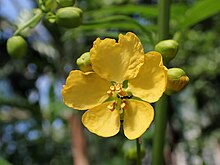| Smooth senna | |
|---|---|

| |
| Scientific classification | |
| Kingdom: | Plantae |
| Clade: | Tracheophytes |
| Clade: | Angiosperms |
| Clade: | Eudicots |
| Clade: | Rosids |
| Order: | Fabales |
| Family: | Fabaceae |
| Subfamily: | Caesalpinioideae |
| Genus: | Senna |
| Species: | S. barclayana |
| Binomial name | |
| Senna barclayana (Sweet) Randell | |
| Synonyms | |

Senna barclayana, commonly known as smooth senna or pepper-leaf senna, is a species of flowering plant in the family Fabaceae and is endemic to eastern Australia. It is a herbaceous perennial or subshrub with pinnate leaves with six to ten pairs of lance-shaped or narrowly elliptic leaflets, and yellow flowers in groups of six to ten.
Description
Senna barclayana is an erect, herbaceous perennial subshrub that typically grows to a height of up to 1.5 m (4 ft 11 in). Its leaves are pinnate, 80–120 mm (3.1–4.7 in) long on a petiole 10–20 mm (0.39–0.79 in) long, with six to ten pairs of lance-shaped or narrowly elliptic leaflets 20–50 mm (0.79–1.97 in) long and 4–9 mm (0.16–0.35 in) wide. There is a sessile gland near the base of the petiole, and a stipule that falls off as the leaf opens. The flowers are yellow and arranged in upper leaf axils in pairs or groups of six to ten on a peduncle 20–35 mm (0.79–1.38 in) long, each flower on a pedicel 12–20 mm (0.47–0.79 in) long. The petals are up to 20 mm (0.79 in) long and there are six fertile stamens and four staminodes, the longest anthers about 3 mm (0.12 in) long. Flowering occurs all year, and the fruit is a cylindrical pod 30–50 mm (1.2–2.0 in) long.
Taxonomy
This species was first formally described in 1827 by Robert Sweet who gave it the name Cassia barclayana in his Flora Australasica. In 1988, Barbara Rae Randell transferred the species to Senna as Senna barclayana in the Journal of the Adelaide Botanic Garden. The specific epithet (barclayana) honours Robert Barclay of Bury-hill (1751–1830).
Distribution and habitat
Senna barclayana grows in open forest southern Queensland and northern New South Wales, but its range is increasing and it is now naturalised in Victoria, South Australia and Western Australia.
References
- ^ "Senna barclayana". Australian Plant Census. Retrieved 3 June 2023.
- ^ Wiecek, Barbara. "Senna barclayana". Royal Botanic Garden Sydney. Retrieved 3 June 2023.
- ^ "Senna barclyana". Australian Biological Resources Study, Department of Agriculture, Water and the Environment: Canberra. Retrieved 31 May 2023.
- ^ Randell, Barbara Rae (1988). "Revision of the Cassiinae in Australia. 1. Senna Miller sect. Chamaefistula (Colladon) Irwin and Barneby". Journal of the Adelaide Botanic Gardens. 11 (1): 34–36. Retrieved 3 June 2023.
- "Cassia barclayana". Australian Plant Name Index. Retrieved 3 June 2023.
- ^ Sweet, Robert (1827). Flora Australasica. London: James Ridgway. p. 32. Retrieved 3 June 2023.
- "Senna aciphylla". Australian Plant Name Index. Retrieved 3 June 2023.
- Sharr, Francis Aubi; George, Alex (2019). Western Australian Plant Names and Their Meanings (3rd ed.). Kardinya, WA: Four Gables Press. p. 143. ISBN 9780958034180.
- Walsh, Neville G.; Stajsic, Val. "Senna barclayana". Royal Botanic Gardens Victoria. Retrieved 3 June 2023.
| Taxon identifiers | |
|---|---|
| Senna barclayana |
|
| Cassia barclayana | |